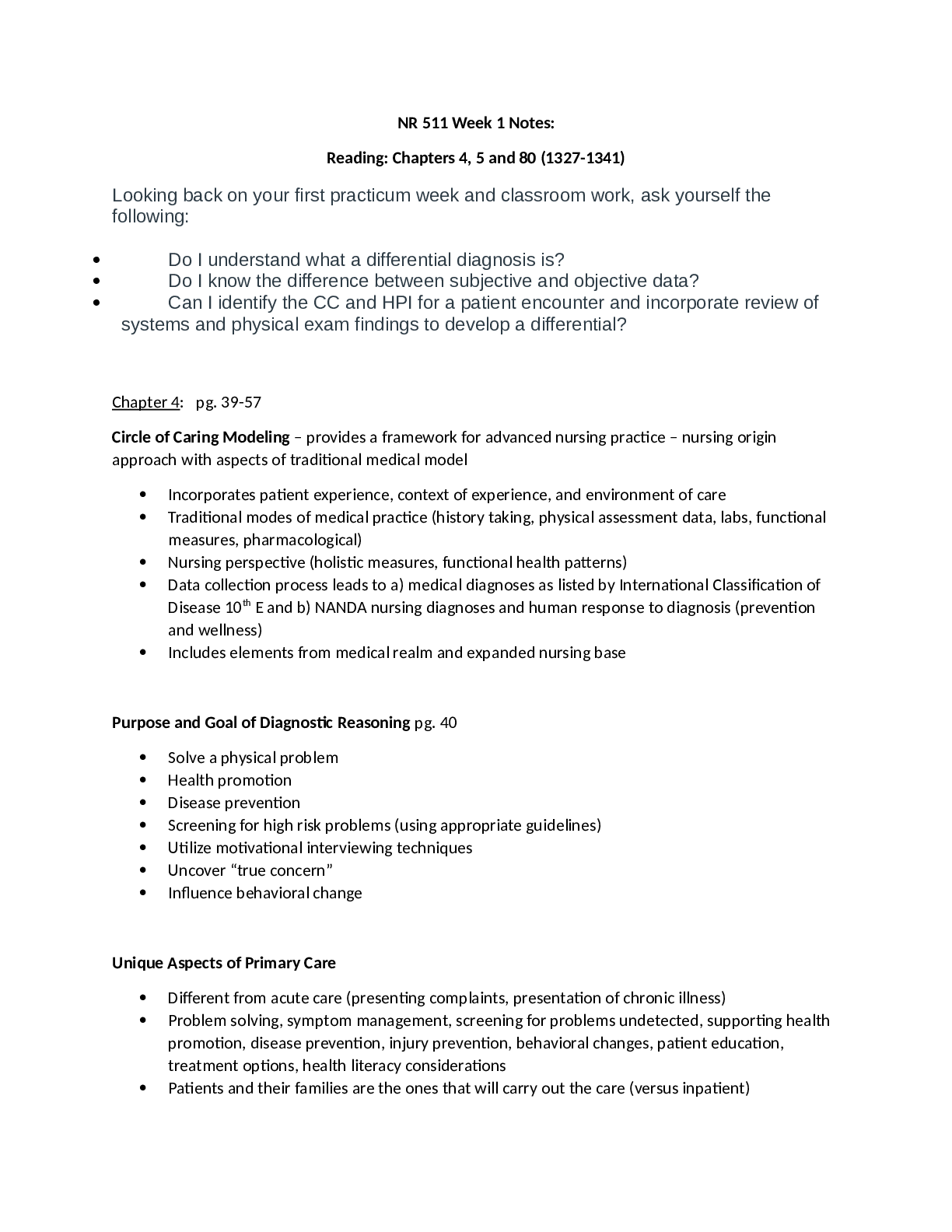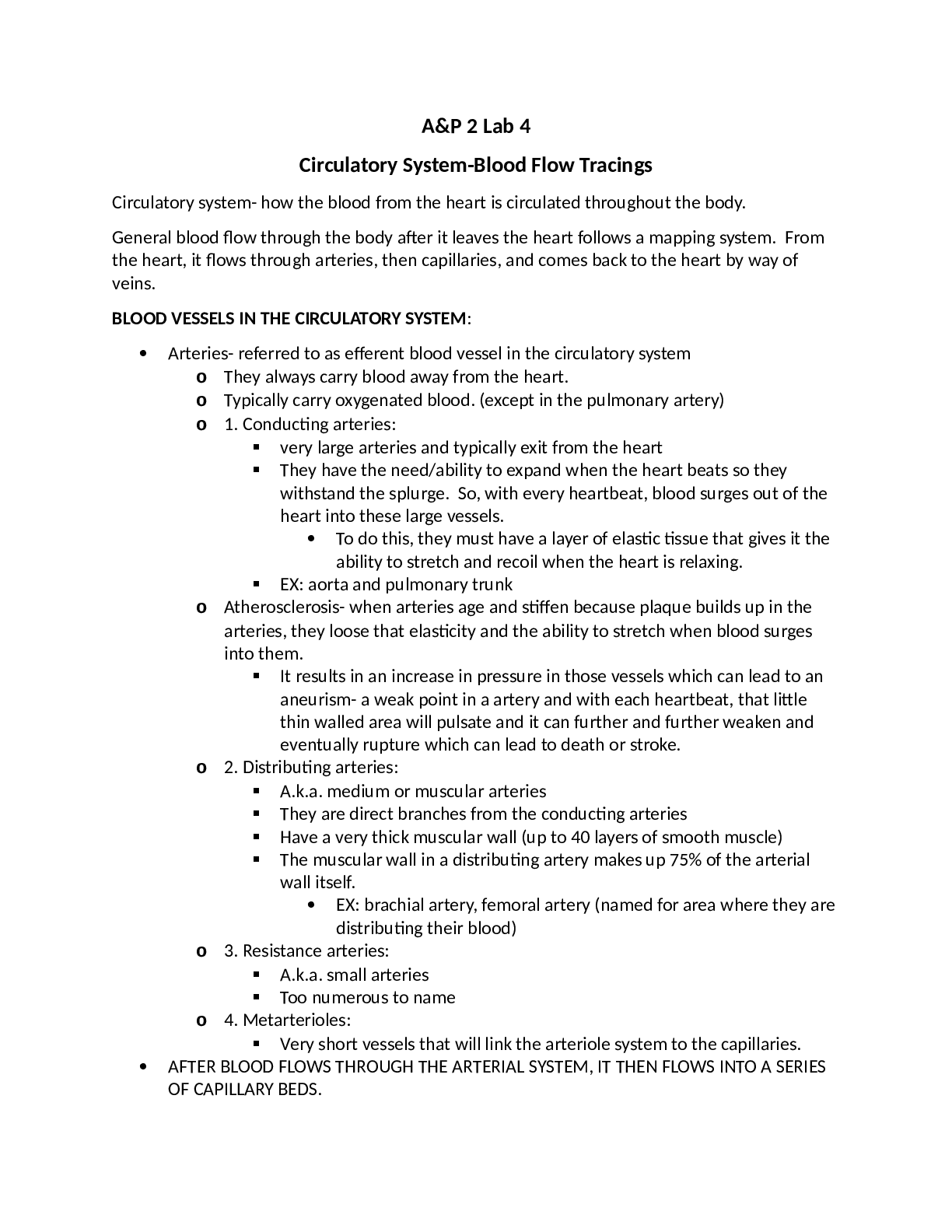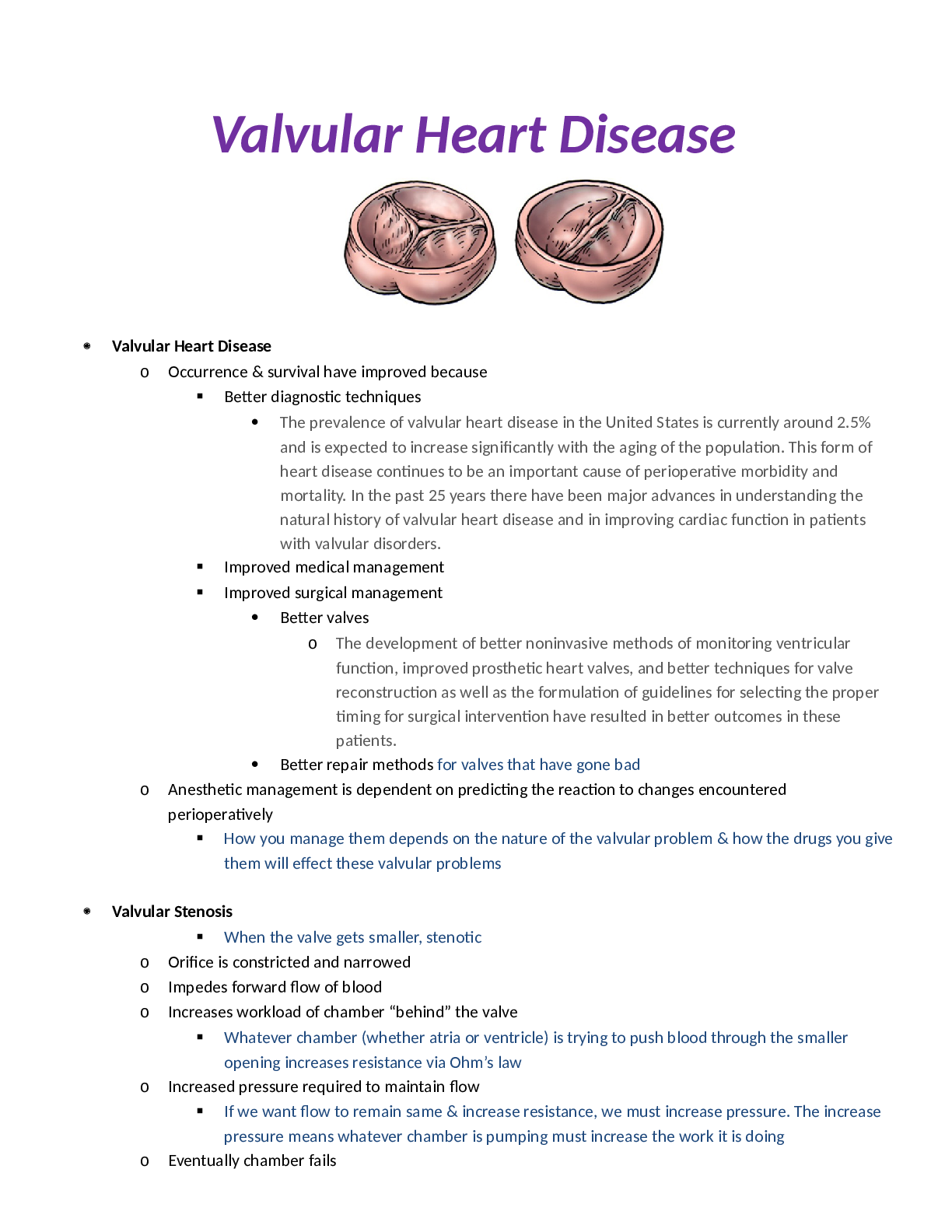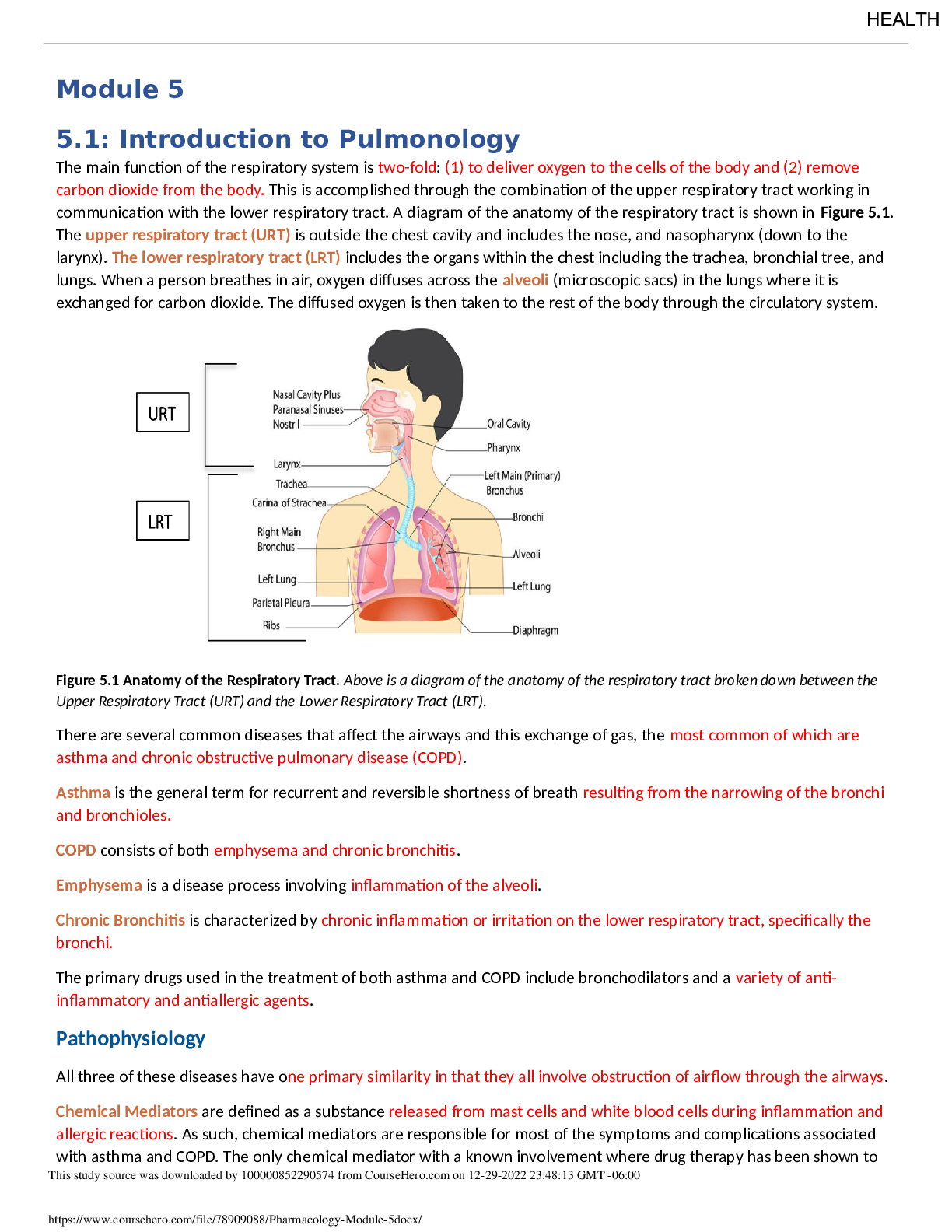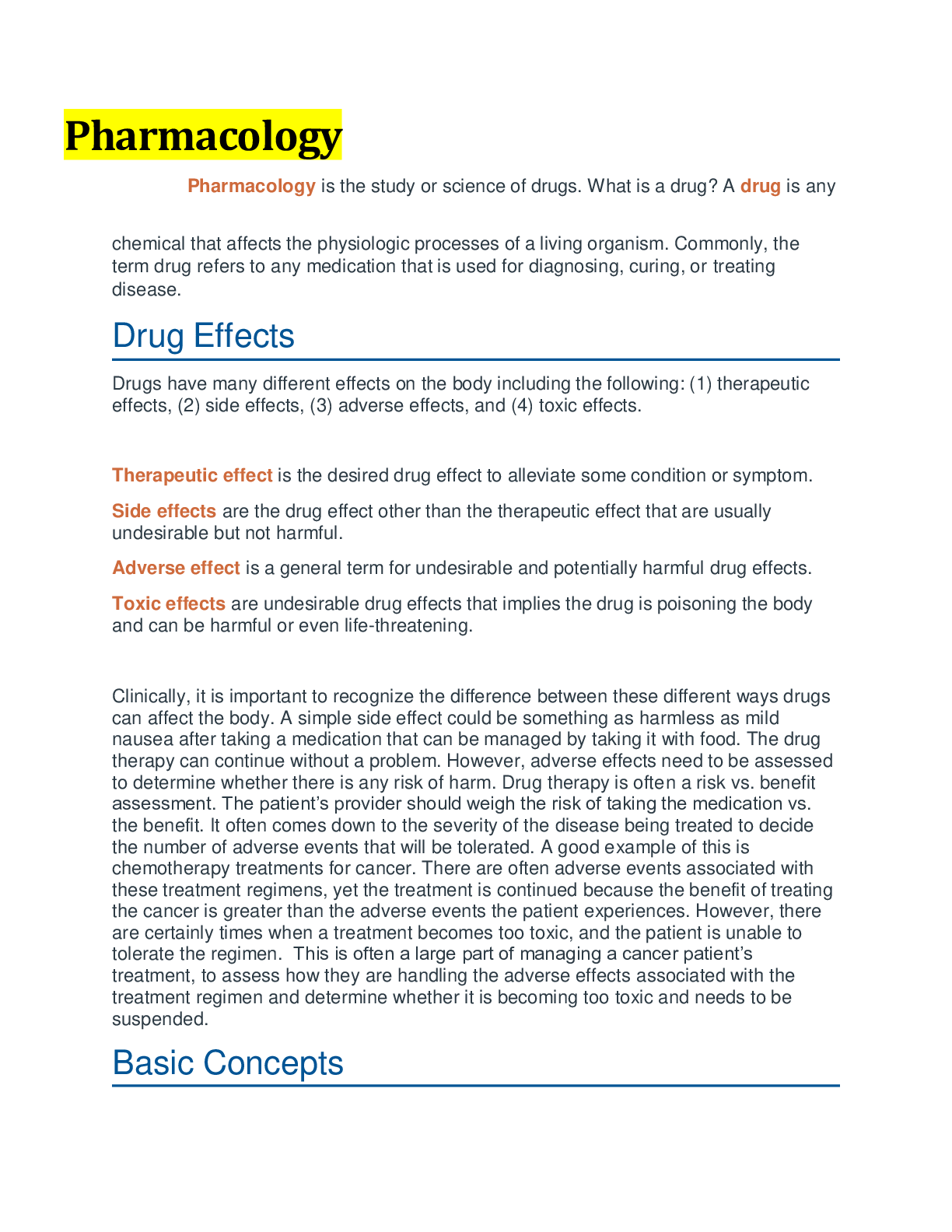*NURSING > Study Notes > 48 Nursing Diagnosis and Planning Related to Skin Integrity and Wound Care. (All)
48 Nursing Diagnosis and Planning Related to Skin Integrity and Wound Care.
Document Content and Description Below
48 Nursing Diagnosis and Planning Related to Skin Integrity and Wound Care. Diagnostic Labels Determining nursing diagnoses involves critical clinical decision-making based on comprehensive data ... collection. Nursing diagnoses related to skin integrity and wound care are selected after identifying patient problems. Once selected, nursing diagnoses are individualized based on collected patient data. Several appropriate North American Nursing Diagnosis Association International (NANDA-I) nursing diagnostic labels related to skin integrity and wound care include: • Impaired Skin Integrity related to compromised nutritional status and immobility, as evidenced by pressure ulcers on the hip and heel. • Impaired Physical Mobility related to pain during position changes, as evidenced by the patient’s grimacing when turned in bed. • Impaired Tissue Integrity related to pressure ulcer secondary to immobility, as evidenced by a stage III pressure ulcer on the coccyx. • Acute Pain related to second degree burns as evidenced by patient rating pain at 8 of 10 during burn wound care. • Imbalanced Nutrition: Less Than Body Requirement related to increased demand secondary to healing wounds, as evidenced by continued weight loss. • Disturbed Body Image related to change in appearance secondary to surgical incision, as evidenced by patient refusal to look at the incision. • Knowledge Deficit related to lack of familiarity with care products, as evidenced by inability to correctly perform wound care. Examples of International Classification for Nursing Practice (ICNP) nursing diagnoses related to skin integrity are: • Impaired Skin Integrity • Supporting Data: Compromised nutritional status: albumin 2.5 g/dL, prealbumin 15 mg/dL, requires assistance to move from bed to chair, right hip and left heel pressure injuries • Impaired Tissue Integrity • Supporting Data: Pressure, immobility, stage 3 pressure injury on the coccyx • Acute Pain • Supporting Data: Trauma, pain in the area of the wound rated by the patient at 8 of 10 Data and Diagnosis: Scenario Angela, a visiting nurse, is performing an initial assessment on Sarah M., a 73-year-old female recently released from the hospital after a lumpectomy for breast cancer. Sarah has a history of Type II diabetes. She is divorced and lives alone. One of her married daughters lives close by and is in frequent contact. Sarah reports that she “doesn’t do much” and usually just sits and watches TV for most of the day. Angela notes that Sarah’s weight has declined since her hospital discharge, and Sarah informs her that she doesn’t really feel hungry most of the time. Angela performs a thorough physical examination. Although Sarah’s lumpectomy incision appears to be healing normally, Angela notices an unhealed pressure ulcer on Sarah’s right heel. Sarah, however, reports that she was not aware of the wound and does not know when she acquired it. Angela reviews the information she has collected in order to select a correct diagnosis. Objective Data What objective data did Angela collect? • Weight loss • Presence of wound on heel • History of Type II diabetes Initial Nursing Diagnoses What can Angela determine about Sarah’s self-care activities from her assessment thus far? • Limited activity • Decline in weight since hospitalization Diagnostic Statement Based on this assessment, what is an appropriate individualized nursing diagnostic statement for Sarah? Impaired Skin Integrity related to compromised nutritional status and immobility as evidenced by pressure ulcer on the heel. Key Points • Nursing diagnoses related to skin integrity and wound care are selected after identifying patient problems. Based on specific patient data, nursing diagnoses are formulated accordingly. • Common nursing diagnoses related to skin integrity and wound care often involve nutritional status, pressure ulcers, immobility, pain, and other factors that alter skin integrity or impair wound healing. Question 1 of 3 Which nursing diagnoses are appropriate for a patient with a wound? Select all that apply. • Impaired Skin Integrity • Imbalanced Nutrition • Disturbed Body Image • Knowledge Deficit • Impaired Cardiopulmonary Function Exactly! Impaired Skin Integrity Impaired Skin Integrity related to compromised nutritional status and immobility as evidenced by pressure ulcers on the hip and heel is an appropriate nursing diagnosis for a patient with a wound. Imbalanced Nutrition Imbalanced Nutrition: Less Than Body Requirement related to increased demand secondary to healing wounds as evidenced by continued weight loss is an appropriate nursing diagnosis statement for a patient with a wound. Disturbed Body Image Disturbed Body Image related to change in appearance secondary to surgical incision as evidenced by patient refusal to look at the incision is an appropriate nursing diagnosis statement for a patient with a wound. Knowledge Deficit Knowledge Deficit related to lack of familiarity with care products as evidenced by inability to correctly perform wound care is an appropriate nursing diagnosis for a patient with a wound. Impaired Cardiopulmonary Function Impaired Cardiopulmonary Function is not an appropriate nursing diagnosis, since it is not related to wound or wound care. Question 2 of 3 A visiting nurse is performing an initial assessment on an older adult male recently released from the hospital after open heart surgery. The patient has a history of Type II diabetes and is a widower. His children and family all live out of state. The nurse performs a thorough physical examination. Although the patient’s chest incision appears to be healing normally, the nurse notices an unhealed pressure ulcer on the patient’s right toe. What objective data can the nurse collect? Select all that apply. • Depression • Presence of wound on toe • History of type II diabetes • Healing incision on chest • Loneliness Exactly! Depression Depression in this scenario is subjective. Presence of wound on toe Presence of wound on toe is objective, as it is observable. History of type II diabetes History of Type II diabetes is objective and factual. Healing incision on chest Healing incision on chest is objective because it is observable. Loneliness Lonely is subjective in this scenario. Question 3 of 3 Which is a nursing diagnostic statement related to skin integrity and wound care? Impaired Physical Mobility related to pain during position changes, as evidenced by the patient’s grimacing when turned in bed. Acute Pain related to Stevens Johnson Syndrome, as evidenced by patient rating pain at 2 of 10 during burn wound care. Disturbed Body Image related to change in appearance, secondary to surgical incision, as evidenced by patient looking at the incision. Knowledge Deficit related to lack of familiarity with care products, as evidenced by correctly performing wound care. Exactly! Impaired Physical Mobility related to pain during position changes, as evidenced by the patient’s grimacing when turned in bed. Impaired Physical Mobility related to pain during position changes, as evidenced by the patient’s grimacing when turned in bed is correct. Acute Pain related to Stevens Johnson Syndrome, as evidenced by patient rating pain at 2 of 10 during burn wound care. Acute Pain related to second degree burns as evidenced by patient rating pain at 8 of 10 during burn wound care is more appropriate. Disturbed Body Image related to change in appearance, secondary to surgical incision, as evidenced by patient looking at the incision. Disturbed Body Image related to change in appearance secondary to surgical incision as evidenced by patient refusal to look at the incision is more appropriate. Knowledge Deficit related to lack of familiarity with care products, as evidenced by correctly performing wound care. Knowledge Deficit related to lack of familiarity with care products as evidenced by inability to correctly perform wound care is more appropriate. Planning Collaborative Patient Care Once nursing diagnoses are selected and individualized, a plan of care is developed. To promote skin integrity and wound healing, the nurse considers: • Therapies consistent with guidelines for treatment of wounds and pressure ulcers. • Recommendations from collaborating health-care professionals, such as nutritionists, wound care specialists, and social workers. • Agreement of patient and family with plan of care. • Ability of patient and family to participate in interventions and purchase supplies for home care, if required. The nurse has the overall responsibility for patient care planning, collaboration and delegation. Nurses collaborate with other members of the health care team for the purpose of providing optimal patient care and achieving satisfactory patient goals. Nurses may delegate tasks to other members of the health care team depending on the person’s scope of practice or ability to perform those tasks. Let’s look closer at how collaboration and delegation work. Nurse Collaborating Specialists Collaborative Opportunities: Scenario Let’s explore ways in which Angela can collaborate in Sarah M.’s case. Angela must prioritize collaborative activities for Sarah based on Sarah’s needs, self-care abilities, available resources, family involvement, and selected nursing diagnoses. Collaborative Opportunities What collaborative opportunities can Angela pursue for Sarah? Wound specialist: Sarah has a previously undiagnosed and untreated pressure ulcer. Nutritionist: Sarah has lost weight and states she does not feel like eating. Social services: Sarah might need additional resources or assistance because she lives alone and only has the support of one adult child who does not live with her. Family: The daughter is in frequent contact but might not be visiting her mother. The daughter may need additional resources or teaching to adequately provide care for her mother. Collaborative Action What action can Angela take to establish collaborative care for Sarah? Angela will consult with Sarah’s primary care provider to facilitate arrangements for consultations with a wound specialist, a nutritionist, and a social worker. Angela will contact Sarah’s daughter to collect more information about the daughter’s knowledge, ability, time, and need for financial or other resources to adequately care for her mother. Goals Related to Skin Integrity and Wound Care Desired goals or outcomes are determined following collaboration with the patient and other members of the health care team. Goals include specific evaluation criteria. When goals are met, it indicates that interventions for that nursing diagnosis and treatment plan were effective. When goals are not met, the plan of care and specific interventions must be revised, because the plan and interventions were not effective. Goal Examples Examples of goals related to skin integrity and wound care are: • Patient will be able to: o Ingest 75% of each meal during hospitalization. o Participate in position changes within 24 hours. o Show signs of wound healing, as evidenced by presence of granulation tissue in the wound within 1 week. o Report that pain management regimen relieves pain to a level of 3 of 10, or less, within the shift. o Consume nutrition adequate to meet the nutritional requirement within 1 week. o Remain free of infection during hospitalization. o Show acceptance of the change in body image by helping with dressing change within 48 hours. o Verbalize the ability to cope with changes in body image during home care. o State strategies to promote wound healing during patient education sessions. Goals and Outcomes: Scenario After discussions with Sarah, Angela determines appropriate and attainable goals. Goals What are appropriate goals for Sarah? Short-term: 1. Patient will create a nutrition plan, in consultation with the nutritionist, within 1 week. 2. Patient will meet with social worker within 1 week. 3. Patient will consult with wound specialist within 72 hours. 4. Patient will implement appropriate wound care procedures within 72 hours. 5. Patient will show signs of wound healing, as evidenced by granulation tissue in the wound within 1 week. 6. Patient will state strategies to promote wound healing following patient education. Long-term: 1. Patient will implement a nutritional meal program. Outcomes What are appropriate skin integrity and wound care outcomes for Sarah? • Patient regains 5 lbs. • Patient demonstrates no evidence of additional pressure ulcers. • Once nursing diagnoses are selected and individualized, a plan of care is developed based on patient needs and abilities. • Patient care planning is the nurse’s primary responsibility, which includes collaboration and delegation. Tasks are delegated depending on the delegated person’s scope of practice and ability to perform those tasks. • After collaboration with the patient and other members of the health care team, desired goals and outcomes are formulated. • Interventions are deemed effective when skin integrity and wound care goals are met. However, if goals are unmet, the treatment plan and interventions are revised accordingly. Question 1 of 5 Which nursing action is an example of collaboration? Asking UAP to feed a patient Enforcing facility policy and scope of practice guidelines Making a decision as to when to call a wound care specialist Assessing and evaluating a patient’s skin and wounds Exactly! Asking UAP to feed a patient Having UAP feed a patient is delegating. Enforcing facility policy and scope of practice guidelines Enforcing facility policy and scope of practice guidelines is part of nursing professionalism and is not collaboration. Making a decision as to when to call a wound care specialist Making a decision about when to call a wound care specialist is part of the nurse’s role in collaboration. Assessing and evaluating a patient’s skin and wounds Assessing and evaluating a patient’s skin and wounds is a nursing task, not collaborative care. Question 2 of 5 Which tasks can UAP perform in regard to skin integrity and wound care? Select all that apply. • Reporting to the nurse any changes in patient skin condition or integrity • Assessing and evaluating a patient’s skin and wounds • Application of non-sterile dressings for chronic wounds with an established treatment plan in place • Assisting with oral hygiene • Administering medications for pain Exactly! Reporting to the nurse any changes in patient skin condition or integrity UAP can report any changes in the patient’s skin condition or integrity to the nurse. Assessing and evaluating a patient’s skin and wounds Assessing and evaluating a patient’s skin and wounds is a nursing responsibility. Application of non-sterile dressings for chronic wounds with an established treatment plan in place Application of non-sterile dressings for chronic wounds with an established treatment plan in place is a task UAP can perform. Assisting with oral hygiene Assisting with oral hygiene is a task UAP can perform, but is not related to wound care. Administering medications for pain UAP cannot administer medications for pain; this is a nursing duty. Question 3 of 5 Which tasks can be delegated to a family member in regard to skin integrity and wound care? Assisting with hair care Assessing and evaluating a patient’s skin and wounds Supervising UAP Deciding which medications the patient will take Exactly! Assisting with hair care Assisting with hair care can be performed by a family member. Assessing and evaluating a patient’s skin and wounds Assessing and evaluating a patient’s skin and wounds is completed by a nurse, not a family member. Supervising UAP UAP are supervised by a nurse. Deciding which medications the patient will take Family members do not decide which medications a patient will take. Question 4 of 5 Which goals are examples of goals related to skin integrity and wound care? Select all that apply. • Patient will participate in position changes within 24 hours. • Patient will show signs of wound healing, as evidenced by presence of granulation tissue in the wound within 1 week. • Patient will maintain a normal heart rate and blood pressure during rest. • Patient will remain free of infection during hospitalization. • Patient will show acceptance of the change in body image by helping with dressing change within 48 hours. Exactly! Patient will participate in position changes within 24 hours. Participating in position changes within 24 hours is an appropriate goal. Patient will show signs of wound healing, as evidenced by presence of granulation tissue in the wound within 1 week. Showing signs of wound healing as evidenced by presence of granulation tissue in the wound within 1 week is an appropriate goal. Patient will maintain a normal heart rate and blood pressure during rest. Maintaining a normal heart rate and blood pressure during rest is more appropriate for someone with cardiac disease. Patient will remain free of infection during hospitalization. Remaining free of infection during hospitalization is an appropriate goal. Patient will show acceptance of the change in body image by helping with dressing change within 48 hours. Showing acceptance of the change in body image by helping with dressing change within 48 hours is an appropriate goal. Question 5 of 5 Which goal is an example of a long-term goal related to skin integrity and wound care? Patient will meet with social worker within three days. Patient will implement appropriate wound care procedures within 72 hours. Patient will verbalize strategies to promote wound healing following patient education. Patient will implement a nutritional meal program. Exactly! Patient will meet with social worker within three days. Meeting with a social worker within three days is a short-term goal. Patient will implement appropriate wound care procedures within 72 hours. Implementing appropriate wound care procedures within 72 hours is a short-term goal. Patient will verbalize strategies to promote wound healing following patient education. This is not a true goal, as there is no time applied to when the patient will verbalize the strategies to promote wound. Patient will implement a nutritional meal program. This is not a true goal, as there is no time applied to when the patient will implement the nutritional meal program. Summary Now that we have identified appropriate nursing diagnoses, goals, and outcomes for the patient with impaired skin integrity and wounds, let’s see how it all fits together. Nursing diagnoses are selected following a thorough assessment of the patient and identification of patient problems related to altered skin integrity or wounds. Once selected, nursing diagnoses are individualized based on patient data. Common nursing diagnoses related to skin integrity and wound care often involve nutritional status, pressure ulcers, immobility, pain and other factors that alter skin integrity or impair wound healing. The nurse has the overall responsibility for patient care planning, collaboration and delegation; however, some tasks can be delegated depending on the delegated person’s scope of practice or ability to perform those tasks. Assessment and evaluation of wounds cannot be delegated to UAPs. Desired goals or outcomes for skin integrity or wounds are determined following collaboration with the patient and other members of the health care team. When goals and outcomes are met, the plan of care was effective. When goals or outcomes are not met, the plan of care must be revised. Question 1 of 15 The patient is a 68-year-old female who weighs 98 pounds. She has type 1 diabetes and a wound on her heel. Which is an appropriate diagnostic label related to her skin integrity and wound care? o Impaired Skin Integrity related to compromised nutritional status and immobility, as evidenced by a pressure ulcer on the heel. Impaired Skin Integrity related to compromised nutritional status and immobility, as evidenced by a pressure ulcer on the heel is an appropriate diagnostic label. • o Acute Pain related to second-degree burns, as evidenced by patient rating pain at 8 of 10 during burn wound care. Acute Pain related to second-degree burns, as evidenced by patient rating pain at 8 of 10 during burn wound care is incorrect. The patient does not have a burn. • o Imbalanced Nutrition: Less Than Body Requirement related to increased demand, secondary to healing wounds, as evidenced by continued weight loss. Imbalanced Nutrition: Less Than Body Requirement related to increased demand, secondary to healing wounds, as evidenced by continued weight loss is not an appropriate diagnosis statement. Not enough information is given to know if the patient has had weight loss. • o Disturbed Body Image related to change in appearance, secondary wound, as evidenced by patient refusal to look at the heel. Disturbed Body Image related to change in appearance, secondary wound, as evidenced by patient refusal to look at the heel cannot be gleaned from current information. Question 2 of 15 The patient is a 68-year-old female who weighs 98 pounds. She has type 1 diabetes and a wound on her heel. When the nurse asks more questions, she finds that the patient has lost 10 pounds since last month and hasn’t had much of an appetite. Which diagnostic label would be a priority? • o Impaired Skin Integrity related to compromised nutritional status and immobility, as evidenced by a pressure ulcer on the heel. Impaired Skin Integrity related to compromised nutritional status and immobility, as evidenced by a pressure ulcer on the heel is an appropriate label, but the weight loss is of more concern. • o Acute Pain related to second-degree burns, as evidenced by patient rating pain at 8 of 10 during burn wound care. Acute Pain related to second-degree burns, as evidenced by patient rating pain at 8 of 10 during burn wound care. The patient does not have a burn. o Imbalanced Nutrition: Less Than Body Requirement related to increased demand, secondary to a healing wound, as evidenced by continued weight loss. Imbalanced Nutrition: Less Than Body Requirement related to increased demand, secondary to healing wounds, as evidenced by continued weight loss is the current concern given the information. • o Disturbed Body Image related to change in appearance, secondary wound, as evidenced by patient refusal to look at the heel. Disturbed Body Image related to change in appearance, secondary wound, as evidenced by patient refusal to look at the heel cannot be assessed from current information. Question 3 of 15 An older adult male patient is wheelchair bound with wounds to his right elbow, sacrum, and bilateral heels. He has a history of cardiovascular disease with a quadruple bypass surgery 10 years prior. His face grimaces as he tries to move around in the wheelchair. What are two appropriate diagnostic labels related to his skin integrity and wound care? o Impaired Physical Mobility related to pain during position changes, as evidenced by the patient’s grimacing when moving in wheelchair. Impaired Physical Mobility related to pain during position changes, as evidenced by the patient’s grimacing when moving in wheelchair is an appropriate diagnostic statement. o Impaired Tissue Integrity related to pressure ulcer, secondary to immobility, as evidenced by pressure ulcers. Impaired Tissue Integrity related to pressure ulcer, secondary to immobility, as evidenced by pressure ulcers is an appropriate diagnostic statement. • o Imbalanced Nutrition: Less Than Body Requirement related to increased demand, secondary to healing wounds, as evidenced by continued weight loss. Imbalanced Nutrition: Less Than Body Requirement related to increased demand, secondary to healing wounds, as evidenced by continued weight loss cannot be determined from this information. • o Disturbed Body Image related to change in appearance, secondary to surgical incision as evidenced by patient refusal to look at the incision. Disturbed Body Image related to change in appearance, secondary to surgical incision, as evidenced by patient refusal to look at the incision cannot be determined from this information. • o Knowledge Deficit related to lack of familiarity with care products, as evidenced by inability to correctly perform wound care. Knowledge Deficit related to lack of familiarity with care products, as evidenced by inability to correctly perform wound care cannot be determined from this information. Question 4 of 15 An older adult patient with a history of type II diabetes presents for a follow-up visit after a melanoma removed from his cheek. He weighs 90 lb, has a BP of 90/60, and states he feels fatigued. During the physical examination, she notes the surgical incision is healing well without infection, but finds an unhealed pressure ulcer on the patient’s right elbow. What objective data can the nurse collect? • o Fatigue The patient reporting fatigue is subjective data. o BP of 90/60 A blood pressure reading is objective, as it is measurable. o Presence of wound on elbow Presence of wound on the elbow is objective, because it is observable. o History of Type II diabetes History of type II diabetes is objective. • o Weight loss Weight loss cannot be determined from the information given. Question 5 of 15 An older adult patient with a history of type II diabetes presents for a follow-up visit after a melanoma removed from his cheek. He weighs 90 lb, has a BP of 90/60, and states he feels fatigued. During the physical examination, she notes the surgical incision is healing well without infection, but finds an unhealed pressure ulcer on the patient’s right elbow. Which is the most appropriate nursing diagnostic statement? o Impaired Skin Integrity related to compromised nutritional status and immobility, as evidenced by pressure ulcer on the elbow. Impaired Skin Integrity related to compromised nutritional status and immobility, as evidenced by pressure ulcer on the elbow is the most appropriate diagnostic statement. • o Acute Pain related to wound on elbow, as evidenced by patient rating pain at 3 of 10 during wound care. Acute Pain related to wound on elbow as evidenced by patient rating pain at 3 of 10 during wound care is not the most appropriate diagnostic statement. Acute pain is not evidenced by a rating of 3 of 10. • o Imbalanced Nutrition: Less Than Body Requirement related to increased demand, secondary to healing wounds, as evidenced by continued weight loss. Imbalanced Nutrition: Less Than Body Requirement related to increased demand, secondary to healing wounds, as evidenced by continued weight loss cannot be deduced by the above information. • o Knowledge Deficit related to lack of familiarity with care products, as evidenced by inability to correctly perform wound care. Knowledge Deficit related to lack of familiarity with care products as evidenced by inability to correctly perform wound care. Wound care has not been performed. Question 6 of 15 A patient with a wound on his right ankle is about to be discharged. What are plan of care components for the patient to promote skin integrity and wound healing? o Therapies consistent with guidelines for treatment of wounds and pressure ulcers Therapies consistent with guidelines for treatment of wounds and pressure ulcers are an appropriate component of the care plan. o Recommendations from collaborating health care professionals, such as a wound care specialist Recommendations from collaborating health care professionals such as a wound care specialist, is an appropriate component of the care plan. • o Ability of the patient to maintain a pain rating of 8 out of 10 during activities of daily living Ability of the patient to maintain a pain rating of 8 out of 10 during activities of daily living is inappropriate. The patient would be in too much pain to complete activities of daily living. o Agreement of the patient with the plan of care The patient should agree with the established care plan to encourage compliance. o Ability of the patient to participate in interventions and purchase supplies for home care if required Ability of the patient to participate in interventions and purchase supplies for home care is an appropriate component of the care plan. Question 7 of 15 Which actions are examples of a nurse properly delegating a task? o Reassessing and evaluating treatment plan efficacy Reassessing and evaluating treatment plan efficacy is part of delegation, to ensure delegation is appropriate for the plan. o Decision-making about what can and cannot be delegated to UAP, other health care workers, or family members Decision-making about what can and cannot be delegated to UAP, other health care workers, or family members is part of delegation. o Supervising UAP Supervising UAP is part of delegation; however, the nurse is still responsible for patient care. o Enforcing facility policy and scope of practice guidelines Enforcing facility policy and scope of practice guidelines is correct. • o Decision-making about when to enlist assistance of a wound care or incontinent specialist for at-risk patients Decision-making about when to collaborate with a wound care or incontinent specialist for at-risk patients is an example of collaboration. Question 8 of 15 Which actions are examples of a UAP collaborating with a nurse? o Reporting to the nurse any changes in patient skin condition or integrity Reporting to the nurse any changes in patient skin condition or integrity is an appropriate example and within the scope of practice of UAP. • o Administering pain medications Administering pain medications cannot be delegated to UAP. o Performing limited dressing changes, depending on the setting and treatment Performing limited dressing changes depending on the setting and treatment is an appropriate example, as it is within the scope of practice of UAP. • o Assessing the effectiveness of a wound care program Assessing the effectiveness of a wound care program is the nurse’s responsibility. • o Selecting products based on insurance coverage The family selects products based on insurance coverage or financial concerns, not the UAP. Question 9 of 15 Which task is a UAP unable to perform in regard to skin integrity and wound care? • o Reporting to the nurse any changes in patient skin condition or integrity, elevation in temperature Reporting to the nurse any changes in patient skin condition or integrity, elevation in temperature is expected from UAP. o Assessing and evaluating a patient’s skin and wounds Assessing and evaluating a patient’s skin and wounds is a nursing responsibility. • o Application of non-sterile dressings for chronic wounds with an established treatment plan in place Application of non-sterile dressings for chronic wounds with an established treatment plan in place is a task UAP can perform. • o Assisting with oral hygiene Assisting with oral hygiene is a task UAP can perform. Question 10 of 15 An older adult patient has a stage III pressure ulcer on his sacrum. Which collaboration specialists would the nurse consult? • o Patient The patient is not a collaboration specialist. o Wound care specialist A wound care specialist would be consulted in this situation to ensure proper healing of the pressure ulcer. o Incontinent specialist An incontinent specialist would be part of the collaboration team to ensure the patient does not become incontinent. o Social worker A social worker would be part of the collaboration team in this situation to ensure the patient has access to community resources. o Family Family is not considered collaboration specialists. Question 11 of 15 The nurse is trying to get the family involved in patient care by delegating some tasks to them. Which tasks are appropriate to delegate? o Providing skin hygiene Providing skin hygiene can be performed by family members. o Assisting with oral hygiene Assisting with oral hygiene is a task that can be delegated to family members. • o Taking vital signs Taking vital signs should be performed by the nurse. • o Taking care of wounds/pressure ulcers Taking care of wounds/pressure ulcers should be performed by a nurse. o Assisting with turning or repositioning, as deemed safe by the nurse Assisting with turning or repositioning, as deemed safe by the nurse can be performed by family members. Question 12 of 15 An older adult patient has stage I wounds to his right elbow, sacrum, and bilateral heels. His face grimaces as he tries to move around in the wheel chair. He weighs 125 pounds. His daughter says he looks thinner in the past few weeks. What collaborative opportunities can the nurse pursue for this patient? o Wound specialist A wound care specialist should be part of the collaboration team to address the patient’s wounds. o Nutritionist A nutritionist should be consulted due to the fact the patient has lost weight. o Social services The patient may need additional community resources, so a social worker should be part of the collaboration team. • o Surgeon A surgeon does not need to be consulted yet, as wounds are only stage I. o Family The daughter may need additional resources or teaching to adequately provide care for her father. Question 13 of 15 The nurse is performing an initial assessment on an older adult female patient recently recovering from open heart surgery. The patient admits she doesn’t want to look in the mirror and isn’t hungry for lunch. Based on this assessment, which is the most appropriate goal for the patient? • o Ingest 25% of each meal during hospitalization. Ingest 75% of each meal during hospitalization is more appropriate. o Show signs of wound healing, as evidenced by presence of granulation tissue in the wound within 1 week. Show signs of wound healing as evidenced by presence of granulation tissue in the wound within 1 week are most appropriate. • o Report that pain management regimen relieves pain to a level of 8 of 10 or less within the shift. Report that pain management regimen relieves pain to a level of 3 of 10, not 8 of 10, or less within the shift is more appropriate. o Show acceptance of the change in body image by helping with dressing change within 1 week. Show acceptance of the change in body image by helping with dressing change within 48 hours, not 1 week, is more appropriate. Question 14 of 15 A nurse is performing an initial assessment an 87-year- old female recently recovering from open heart surgery. The patient admits she doesn’t want to look in the mirror and isn’t hungry for lunch. Based on this assessment, what the most appropriate outcome for the patient? • o Patient will demonstrate no evidence of additional pressure ulcers. Patient demonstrates no evidence of additional pressure ulcers is the most appropriate outcome. • o Patient will ingest 50% of each meal during hospitalization. Ingest 50% of each meal during hospitalization us a goal not an outcome; it is a goal. • o Patient will report that pain management regimen relieves pain to a level of 5 of 10 or less within the shift. Report that pain management regimen relieves pain to a level of 5 of 10 or less within the shift is a goal not an outcome; it is a goal. o Patient will show acceptance of the change in body image by helping with dressing change within 1 week. Show acceptance of the change in body image by helping with dressing change within 1 week is a goal not an outcome; it is a goal. Question 15 of 15 The nurse and patient have discussed goals and outcomes related to skin integrity and wound care. Which statement reflects a misunderstanding on the part of the patient? • o “I will participate in position changes within 24 hours.” The statement, “I will participate in position changes within 24 hours.” shows proper understanding. o “I will be infection by the time I go home.” The statement, “I will be infection free by the time I go home.” indicates a misunderstanding. A proper goal will be to be infection free as soon as possible. • o “I will consume nutrition adequate to meet nutritional requirements within 1 week.” The statement, “I will consume nutrition adequate to meet nutritional requirements within 1 week.” reflects proper understanding. o “My wounds will show signs of healing, as evidenced by presence of granulation tissue in the wound within 1 week.” The statement, “My wounds will show signs of healing, as evidenced by presence of granulation tissue in the wound within 1 week.” reflects proper understanding. [Show More]
Last updated: 1 year ago
Preview 1 out of 30 pages
Instant download

Buy this document to get the full access instantly
Instant Download Access after purchase
Add to cartInstant download
Reviews( 0 )
Document information
Connected school, study & course
About the document
Uploaded On
May 30, 2021
Number of pages
30
Written in
Additional information
This document has been written for:
Uploaded
May 30, 2021
Downloads
0
Views
55

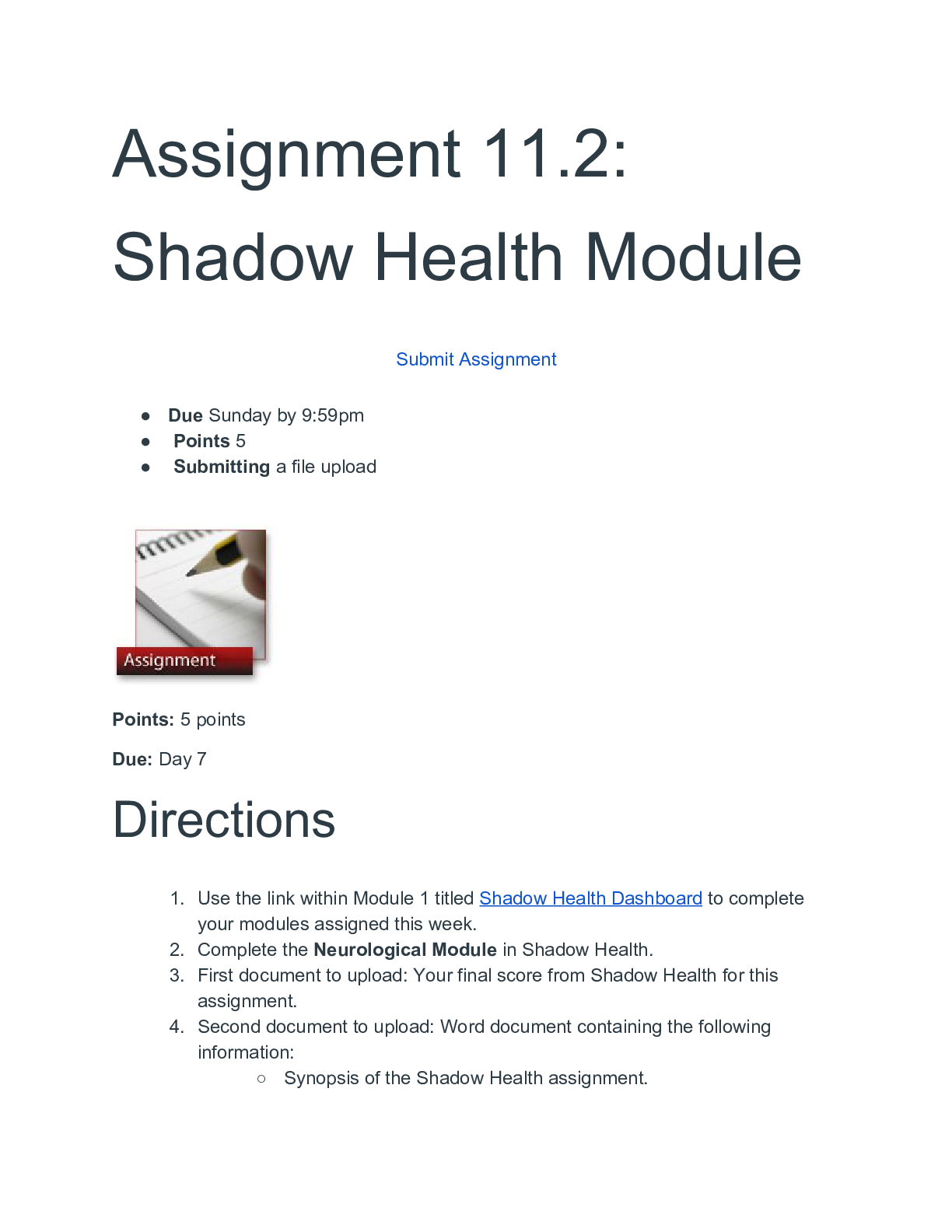
.png)
